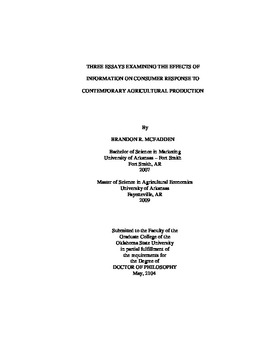| dc.contributor.advisor | Lusk, Jayson L. | |
| dc.contributor.author | McFadden, Brandon R. | |
| dc.date.accessioned | 2015-06-17T20:06:57Z | |
| dc.date.available | 2015-06-17T20:06:57Z | |
| dc.date.issued | 2014-05 | |
| dc.identifier.uri | https://hdl.handle.net/11244/14998 | |
| dc.description.abstract | Future agricultural innovation and increases in the food supply may be limited by consumer aversion to food technology and factors associated with the concentration of production. The ability of agricultural innovators and producers to contribute to these pressing issues depends on how the public assimilates various information. The objective of this dissertation was to contribute to the understanding of consumer concerns about crop biotechnology and hen welfare in egg production and to examine the effect of information on those concerns. The results from this dissertation provide insight into beliefs and preferences for crop biotechnology and agricultural production methods and the effectiveness of advocacy and scientific information. | |
| dc.description.abstract | The first essay examined the results of a survey designed to determine voting intentions prior to the vote of Proposition 37 in 2012, a ballot initiative voted that would have required mandatory labeling of genetically modified foods. Overall, people had inaccurate knowledge about the prevalence of genetically engineered foods and findings suggested that the effectiveness of opposition advertising was likely a formative factor in the defeat of Proposition 37. | |
| dc.description.abstract | The second essay determined beliefs about crop biotechnology compared to a contemporaneous nonagricultural issue. The purpose was to determine the effects of prior beliefs on assimilation of scientific information and test several hypotheses about the manner in which people process scientific information about genetically modified food and global warming. Results indicated that assimilation of information is dependent on prior beliefs and that the failure to converge beliefs to information is a result of several factors. | |
| dc.description.abstract | The third essay amalgamated economics and neuroscience to examine choice and brain activity associated with the tradeoff between farm animal welfare and price. Commercials from advocacy groups surrounding the 2008 campaign of Proposition 2, a ballot initiative to increase the confinement space for some farm animals, were displayed to a number of subjects to determine if brain activation signals how information will be assimilated. Results suggested that the right dorsolateral prefrontal cortex had a larger role in the decision-making and was a better predictor of responsiveness to information than the right dorsolateral prefrontal cortex. | |
| dc.format | application/pdf | |
| dc.language | en_US | |
| dc.rights | Copyright is held by the author who has granted the Oklahoma State University Library the non-exclusive right to share this material in its institutional repository. Contact Digital Library Services at lib-dls@okstate.edu or 405-744-9161 for the permission policy on the use, reproduction or distribution of this material. | |
| dc.title | Three essays examining the effects of information on consumer response to contemporary agricultural production | |
| dc.contributor.committeeMember | Brorsen, B. Wade | |
| dc.contributor.committeeMember | Norwood, F. Bailey | |
| dc.contributor.committeeMember | Zhu, Lan | |
| osu.filename | McFadden_okstate_0664D_13209.pdf | |
| osu.accesstype | Open Access | |
| dc.type.genre | Dissertation | |
| dc.type.material | Text | |
| dc.subject.keywords | animal welfare | |
| dc.subject.keywords | bayesian updating | |
| dc.subject.keywords | behavioral economics | |
| dc.subject.keywords | consumer behavior | |
| dc.subject.keywords | genetically modified foods | |
| dc.subject.keywords | neuroeconomics | |
| thesis.degree.discipline | Agricultural Economics | |
| thesis.degree.grantor | Oklahoma State University | |
